Best Firewood for Heat 2025
- September 18, 2023
- 0 comment
Winter evenings by a roaring fire are unforgettable. The sounds of crackling flames, the warmth wrapping around you, and the flickering embers create a magical atmosphere. However, not every piece of firewood gives you the same warmth and comfort. The right kind of wood can keep your fire burning longer and stronger, while the wrong one might just leave you with a lot of smoke and disappointment. Let’s jump into this guide on the best firewood for heat in 2025, ensuring your fireplace continues to be the warm heart of your home.
1. Hardwoods: The Gold Standard in Firewood
A. Oak
Oak wood is renowned for its density, which significantly influences its burning duration and heat output. As one of the densest woods available, it ensures a long-lasting burn, with a well-seasoned oak log capable of burning for approximately 3 to 4 hours in a controlled environment. This duration, however, can vary depending on factors such as the log’s size and moisture content. In terms of heat output, oak is a powerhouse. Red oak, commonly used for firewood, delivers about 24 million BTUs per cord, and white oak can produce slightly more, ensuring robust and enduring warmth.
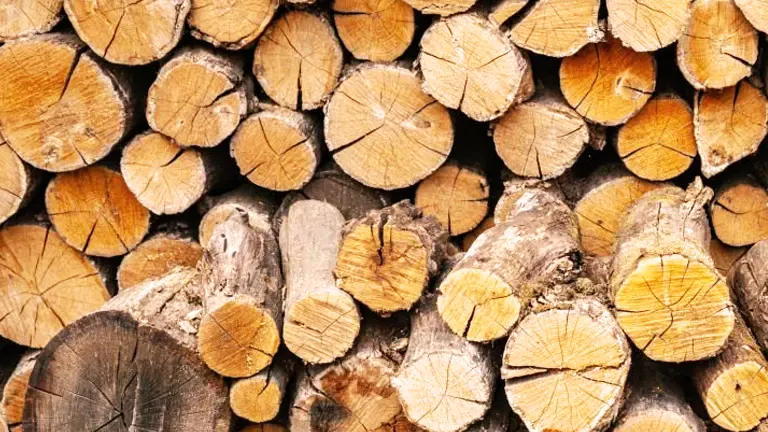
The characteristics of oak extend beyond just its burning capabilities. Its tight grain structure minimizes sparking, making it a safer choice for open fireplaces where spark containment is crucial. Oak also requires a longer seasoning period compared to other hardwoods, typically needing 12 to 24 months to properly dry. This extensive seasoning is crucial for reducing creosote buildup and enhancing the wood’s burning efficiency. Aesthetically, oak offers a slow and even burn, creating a soothing ambiance with its rolling flames and glowing embers, making it ideal for cozy evenings by the fire.
B. Maple
Maple wood, celebrated for its versatility across various species, offers unique burning characteristics that generally align with the robust qualities of hardwoods. Notably, sugar maple stands out for its high heat output, delivering about 24 to 25 million BTUs per cord, making it highly efficient for heating purposes. Silver maple, though slightly lower in heat production at around 19 to 20 million BTUs per cord, still provides substantial warmth. These values highlight maple’s capability to produce a significant amount of heat, suitable for various heating needs.

Aside from its heating capabilities, maple wood also boasts practical advantages in handling and preparation. It requires a relatively moderate seasoning period of 6 to 9 months, shorter than denser woods like oak, due to its lower density. This characteristic not only makes maple quicker to prepare for burning but also easier to split compared to tougher hardwoods such as oak or hickory. Maple’s ease of splitting and shorter seasoning time makes it an accessible option for many, ensuring that it can be prepared and used without extensive effort or specialized equipment.
C. Hickory
Hickory wood, recognized as one of the densest North American hardwoods, excels in both burn quality and workability. This high density not only ensures that hickory logs burn for an extended duration—typically between 3 to 5 hours depending on factors like log size and moisture content—but also contributes to its impressive heat output. You can expect about 24 to 27 million BTUs per cord from hickory, making it one of the most efficient woods for generating warmth, especially in colder climates.
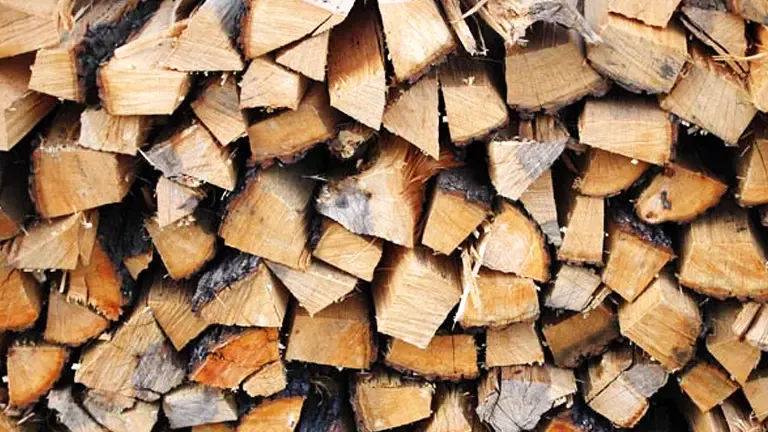
Additionally, hickory is famous for its distinctive, smoky aroma when burned, which is highly prized in culinary circles, particularly for smoking meats where it imparts a rich, flavorful taste. To achieve the best burning efficiency and aroma, hickory should be seasoned for about 12 to 24 months. While its density makes hickory more challenging to split than softer hardwoods, requiring more effort during the preparation phase, the benefits in terms of heat output and sensory experience are often considered well worth the extra work.
| Characteristic | Oak | Maple | Hickory |
|---|---|---|---|
| Density | Very Dense | Moderately Dense | Very Dense |
| Burn Time | Long | Medium to Long | Long |
| Heat Output (BTUs) | High | High | Very High |
| Ease of Splitting | Moderate (depends on species) | Easier than Oak and Hickory | Challenging due to toughness |
| Spark Production | Minimal | Minimal | Minimal |
| Aroma When Burned | Mild, Woody | Mild with a hint of sweetness | Rich, Smoky (reminiscent of smoked meats) |
| Seasoning Time | Extended (1-2 years for optimal results) | Moderate (6 months to a year) | Extended (1-2 years for optimal results) |
| Creosote Buildup Risk | Low to Moderate (with proper seasoning) | Low | Low to Moderate (with proper seasoning) |
| Availability | Widely available in many regions | Widely available, especially in North America | Available but less common than Oak and Maple |
2. Fruitwoods: A Flavorful Burn
Fruitwoods, as the name suggests, come from trees that bear fruit. These woods are not just known for their heating abilities but also for the distinct aromatic scents they release when burned. They’re especially popular in smoking and barbecuing due to their unique aromatic properties.
A. Apple
Apple wood, often linked with picturesque orchards and delightful pies, holds a cherished spot in the firewood community due to its efficient burning characteristics and unique aromatic qualities. Its dense nature allows for a slow, enduring burn, making it an excellent choice for those seeking sustained warmth. The real allure of applewood, however, lies in its scent. As it burns, it releases a mild and sweet aroma that can remind one of walking through sun-drenched apple orchards.
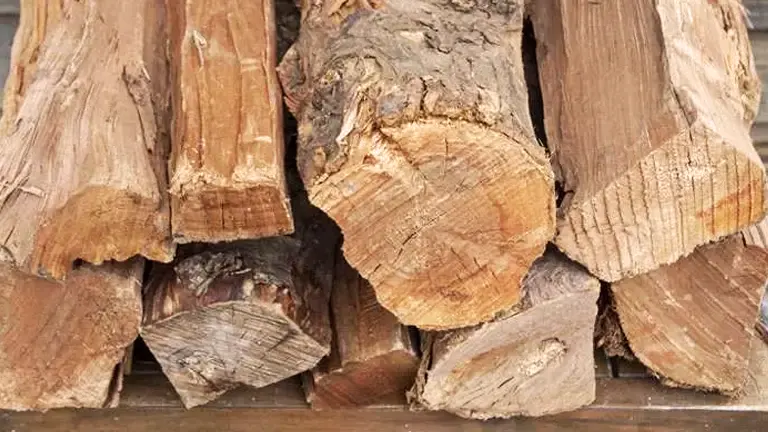
This unique aroma not only enhances the ambiance of any room but also makes applewood a preferred choice for culinary smoking, imparting a subtle fruity note to foods. While it might not rival the intense heat output of heavy hardwoods like oak or hickory, applewood delivers reliable and pleasant warmth, making it a favorite for many.
B. Cherry
Cherry wood brings a unique combination of beauty and utility to the world of firewood. Known for its rich, reddish hue, cherry wood is a popular choice not only in woodworking but also as an effective firewood. It burns at a steady, moderate pace, providing a consistent warmth that’s ideal for a relaxing evening by the fire. Although cherry may not match the highest density hardwoods in burn duration, its performance is still commendable, making it a reliable source of heat.
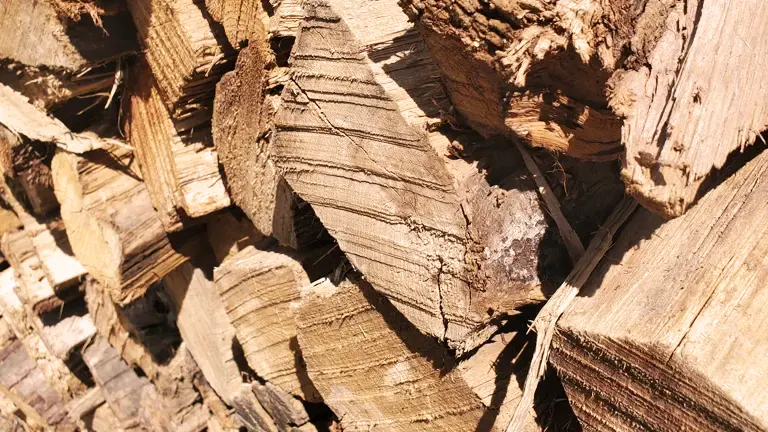
What sets cherry wood apart is its aromatic qualities. As it burns, it releases a gentle and sweet fragrance that enhances the atmosphere, creating a pleasant and memorable sensory experience. While cherry wood might not lead the pack in terms of heat output (BTU), its ability to blend functional warmth with an appealing aroma makes it a favorite among those who appreciate a holistic approach to their fireplace experience. This combination of visual appeal, adequate heat, and a delightful scent ensures cherry wood remains a sought-after choice for those looking to enrich their firewood experience.
3. Evergreens: A Word of Caution
A. Pine
Pine is commonly used as firewood due to its abundant availability and ease of ignition. This makes it a popular choice for quickly generating heat, particularly valuable when immediate warmth is needed. However, pine also contains high levels of sap and resins, which can complicate its use as firewood. When burned, these substances can release creosote, a flammable byproduct that may accumulate in chimneys and flues. This buildup can increase the risk of chimney fires if not regularly managed through cleaning.
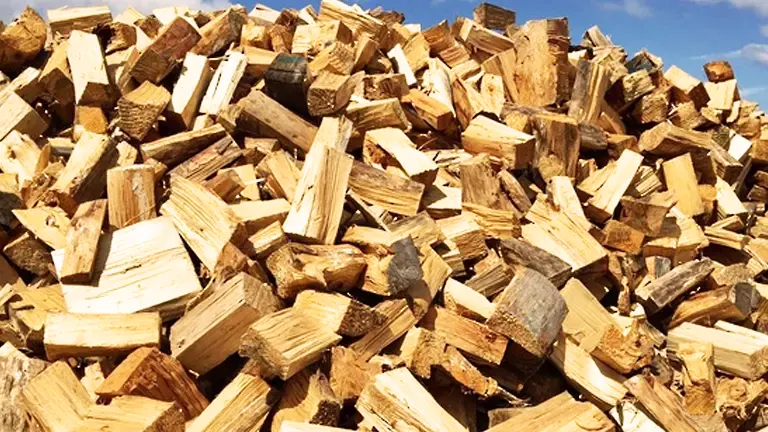
Due to its rapid burning properties and the potential risks associated with its sap content, pine is often recommended primarily as kindling. It’s ideal for starting fires but should be used carefully and in combination with other, harder woods that burn more slowly and produce less creosote. This strategy allows pine to serve as an effective starter while other woods provide a longer-lasting and safer burn for heating purposes.
B. Fir
Fir wood, similar to pine, is part of the evergreen family and shares many burning characteristics with its sibling. It ignites quickly, providing a rapid burst of heat which can be especially comforting during chilly days. However, fir also contains resins that can lead to the buildup of creosote in chimneys when burned. This doesn’t make fir unusable for firewood, but it does require cautious use to ensure safety.
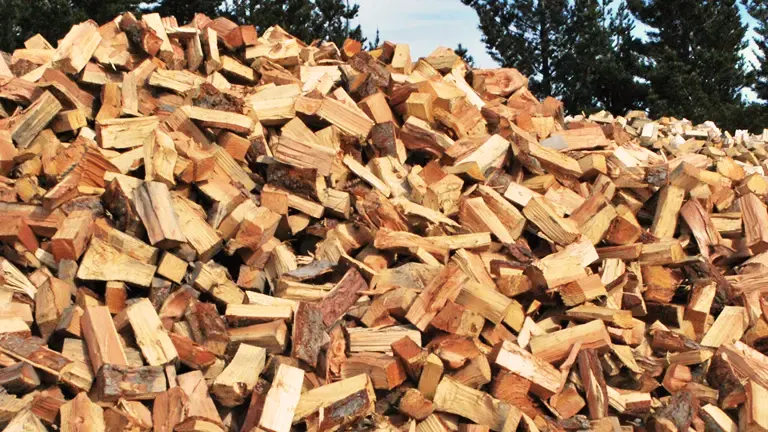
A practical approach to using fir is to combine it with hardwoods in your fire. Starting your fire with fir can quickly heat the space, and then switching to longer-burning hardwoods like oak or maple can maintain the fire’s warmth while minimizing the risk of excessive creosote accumulation. This method leverages fir’s quick-burning properties for initial heat and uses hardwoods for sustained burning, optimizing both heat output and safety. This strategic use of different wood types ensures efficient heating while mitigating the risks associated with high-resin softwoods.
4. Seasoning: The Secret Ingredient
Seasoning firewood is crucial because freshly cut wood is typically saturated with moisture, often up to 50% or more. This high moisture content can greatly reduce the wood’s burning efficiency as a lot of the heat generated during combustion is used to evaporate water, resulting in more smoke and less usable heat. The goal of seasoning is to reduce the moisture content to below 20%. At this level, the wood burns more effectively, producing higher heat and fewer emissions, including less smoke and creosote, which can build up in chimneys and pose a fire hazard.
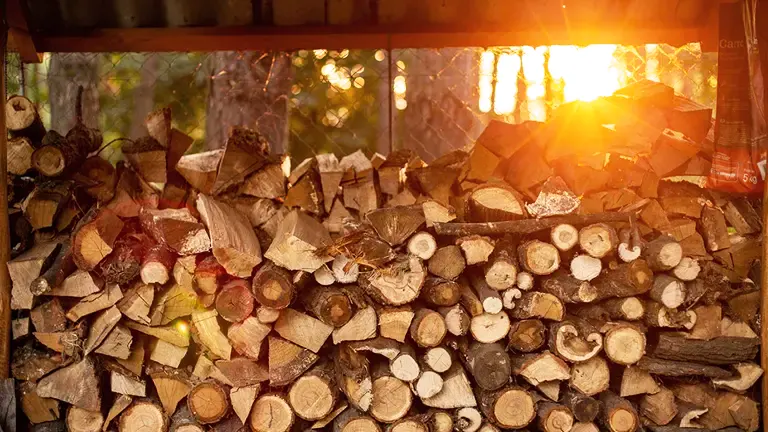
The seasoning process generally takes about six months to a year, but longer is often better. Wood that’s been allowed to dry over longer periods burns even more efficiently. Proper storage is key during this time; wood should be stacked in a manner that allows air to circulate freely around each piece, ideally in a sunny, covered area to prevent reabsorption of moisture from rain. Think of seasoning wood as akin to aging wine—the longer and more carefully you do it, the better the results in terms of both heat output and burning quality. Properly seasoned wood not only offers superior heating properties but also contributes to safer and more enjoyable fire experiences.
5. Going Beyond the Burn: A Few Tips
A. Storage
Proper storage is crucial for maintaining the quality and burning efficiency of firewood. Storing wood directly on the ground can lead to moisture absorption from the soil, which hampers the drying process and can re-moisten already seasoned wood. To prevent this, it’s best to store wood off the ground using racks, pallets, or by elevating it in some other way. This approach not only helps keep the wood dry but also extends its usability.
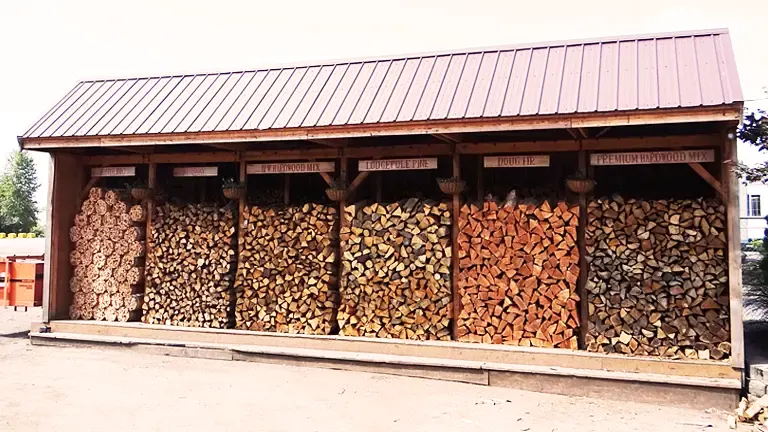
Additionally, ensuring that your storage area is well-ventilated is essential. A space that allows air to freely circulate around the wood helps speed up the seasoning process and prevents the growth of mold. Using a dedicated woodshed or an open but covered structure can be very effective. These storage methods ensure that the wood remains dry, clean, and ready for efficient burning, keeping it in optimal condition for use in your fireplace or stove.
B. Mix and Match
Mixing different types of firewood can greatly enhance your fire-burning experience by combining the unique characteristics of each wood type. For example, oak, known for its long burn duration and high heat output, makes a solid base for your fire. Adding cherry wood to the mix introduces a lighter, sweetly aromatic component. This combination not only sustains the fire for an extended period due to oak’s density but also infuses the air with the pleasant, inviting aroma of cherry.
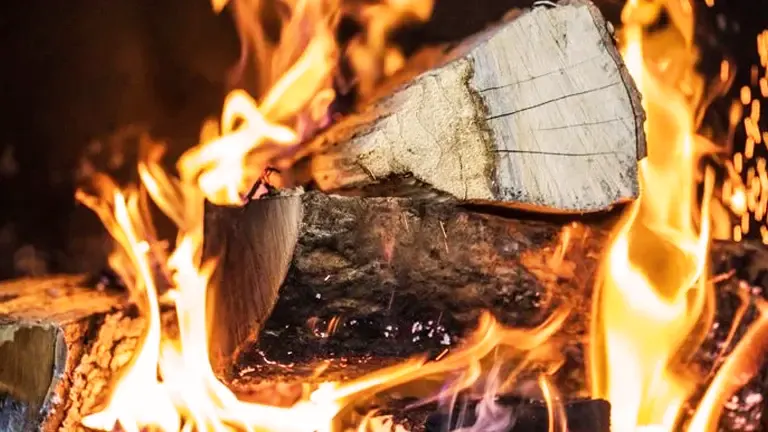
This approach not only maximizes the efficiency and longevity of your fire but also transforms it into a multisensory experience. The robust heat from the oak ensures you stay warm, while the cherry wood’s scent enriches the atmosphere, making your fireplace a captivating aromatic centerpiece for the evening. Mixing woods like these allows you to tailor your fire to meet specific needs, whether it’s for heat, ambiance, or both.
C. Safety First
While the warmth and ambiance of a wood-burning hearth are undeniably appealing, it’s crucial to prioritize safety to ensure that this comfort doesn’t turn into a hazard. Burning wood, particularly resinous types, can lead to the buildup of creosote within your chimney. Creosote is a flammable, tar-like substance that can accumulate over time and poses a significant risk of chimney fires if not regularly cleaned.
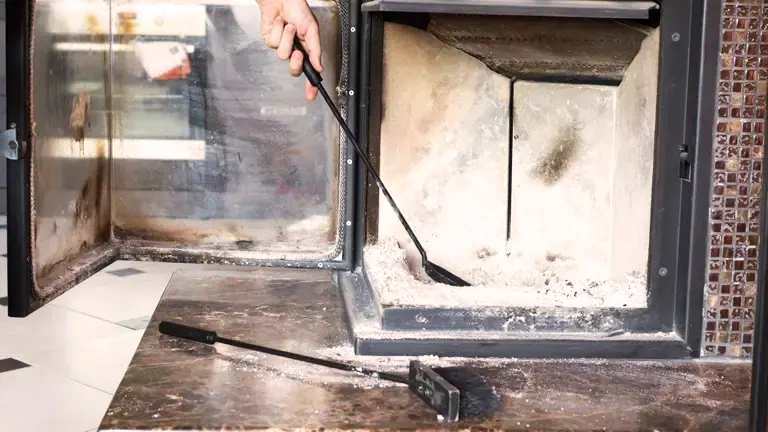
To prevent such dangers, it’s essential to perform an annual chimney sweep. This routine maintenance is not just a recommendation—it’s a critical safety measure. Regular inspections and cleanings help maintain your fireplace’s efficiency and safety, ensuring that your cozy hearth continues to be a source of joy and comfort rather than concern. By staying diligent with these precautions, you can enjoy the benefits of your wood-burning fireplace safely and effectively.
Conclusion
Selecting the best firewood for heat isn’t just about warmth; it’s about the experience. By understanding the characteristics of different types of wood, you can ensure that every fire you light is efficient, aromatic, and mesmerizing. So, the next time you’re stocking up for winter, keep this guide in mind and elevate your fireside moments.
FAQs
- Why is hardwood generally preferred over softwood for heating?
Hardwoods, derived from deciduous trees like oak and maple, are denser and burn slower, producing consistent and long-lasting heat. Softwoods, on the other hand, tend to burn faster and hotter but for shorter durations. - Can firewood be too old to burn?
While seasoned wood is ideal for burning, wood that’s been left exposed to elements for many years can deteriorate or rot. While it may still burn, the heat output could be diminished, and it might produce more smoke. - Why is “seasoned” wood crucial for optimal burning?
Seasoning refers to the drying process, which reduces the moisture content in wood. Properly seasoned wood (with moisture content below 20%) burns more efficiently, produces more heat, and results in less creosote buildup in chimneys. - What’s the deal with creosote, and why should I be concerned?
Creosote is a tar-like substance that accumulates in chimneys from burning wood, especially from unseasoned or resinous wood. Excessive creosote buildup can be flammable, leading to chimney fires. - How does altitude affect firewood burning?
At higher altitudes, the air contains less oxygen, which can affect the combustion efficiency of wood. You might find that wood burns slightly faster and cooler in higher altitudes compared to sea level. - Are there any woods I should avoid burning?
Yes, woods like poison ivy, poison oak, or poison sumac release toxic fumes when burned. Additionally, treated or painted wood can release harmful chemicals into the air. - Can I use firewood ash in my garden?
Yes! Wood ash can be a good source of lime and potassium for gardens. However, ensure it’s pure wood ash without any additives or remnants from treated wood. - Does the bark of firewood matter when burning?
While bark doesn’t significantly impact the BTU value of the wood, it can influence how the wood ignites. Bark can act as an insulator, slowing down the initial catch. But, it can also be useful as kindling in some cases. - Why do some woods pop and crackle when burned?
This is often due to the sap content and trapped moisture in the wood. As the wood burns, the moisture turns to steam, and the sap becomes volatile, causing the wood to pop or crackle. - How does wood’s BTU rating influence its heating capability?
The BTU (British Thermal Unit) rating indicates the amount of heat energy a wood type produces when burned. Woods with higher BTU ratings provide more heat, making them more efficient for warming spaces.
We’d love to hear from you! Share your personal experiences and preferences on the best firewood for heat in 2025 in the comments section below. Your insights could help fellow homeowners choose the right wood for their heating needs!

David Murray
Forestry AuthorI'm David Murry, a forestry equipment specialist with a focus on chainsaw operation. With over 13 years of experience, I've honed my skills in operating and maintaining a wide range of machinery, from chainsaws to log splitters. My passion for the outdoors and commitment to sustainable forestry drive my work, which emphasizes safety, efficiency, and staying updated with industry advancements. Additionally, I'm dedicated to sharing my expertise and promoting environmental awareness within the forestry community.













Leave your comment